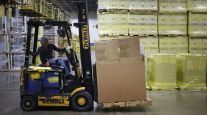Senior Reporter
June Trailer Orders Plunge 50%

This story appears in the Aug. 8 print edition of Transport Topics.
U.S. trailer orders in June sank about 50% from especially robust volumes a year earlier, as the stagnant freight market also prompted a spike in cancellations and a sharp decline in backlog, analysts said.
At the same time, trailer manufacturing capacity is expanding and speculation about a possible pre-buy has started ahead of the federal greenhouse-gas rules expected to be issued this month.
ACT Research Co. said orders for new trailers dropped 51% to 13,532 units, compared with 27,888 in June 2015.
“June orders were the lowest since July 2012, and cancellations were at the highest rate in a few years, as far as we measure it, as a percent against the existing backlog,” Frank Maly, ACT’s director of commercial vehicle transportation analysis and research, told Transport Topics.
Total cancellations rose to 2% — compared with 0.6% in May — and for dry vans it was 2.2%.
“Reefers were not immune, and there was pressure on some of the vocational side, too,” Maly said.
June “was kind of like the alarm going off” indicating the strong growth cycle has finally softened, said Don Ake, vice president of commercial vehicles at the research firm FTR. FTR pegged orders at 11,900, a 56% decline from a year earlier.
The backlog of trailers ordered but not built dropped by 15,000 units in June, Ake said, “likely a record drop for one month.”
Ake said his 2017 U.S. trailer build forecast is for about 250,000 units, calling that somewhat higher than typical replacement level due to continued reefer momentum and dry van replacements.
“The forecast assumes [gross domestic product] growth of 2%. If the economy doesn’t improve from current levels, the build will be lower,” he said.
“As far as backlogs go,” Richard Dauch, CEO of wheel manufacturer Accuride Corp., said during a recent earnings conference call, “we are still seeing replacement demand for 15- to 20-year-old trailers hold and maybe a little bit of pre-buy ahead of the upcoming GHG Phase 2 regulation’s impact that’s going to hit the trailer market this year.”
Phase 1 of greenhouse gases was aimed at trucks and their engines, but the proposed version of Phase 2 includes trailers made in 2018.
Larry Roland, director of marketing for Utility Trailer Manufacturing Co., also mentioned a possible pre-buy.
“2017 may even prove to be a better year than forecast for trailers, as some have suggested that we may experience a pre-buy ahead of the 2018 GHG requirements,” he said, but he declined to elaborate.
Meanwhile, Roland said Utility was “certainly experiencing a softening from years past, although the trend is still following a fairly typical pattern for this time of year.”
“I think it is likely we are past the peak, and we will see smaller orders going forward, at least in the near term,” said Glenn Harney, chief sales officer for Hyundai Translead. “Our backlog is still strong enough that we expect to finish 2016 at a nice pace.”
David Gilliland, vice president of national accounts at Great Dane Trailers said, “June was a very slow month for dry van orders. . . . We do expect that we have reached the peak in demand, and we are likely to see more traditional order intake and backlog into 2017.”
David Giesen, vice president of sales for Stoughton Trailers, said that industrywide dry van orders “were a bit low at 5,559. A normal June will have 6,000 to 8,000 new dry van orders, but new orders are historically lowest in the months of June, July and sometimes August.”
Asked about manufacturing capacity, Charles Willmott, chief sales officer of Strick Group, said, “A very smart fellow once told me, ‘The downturn always starts the day you sign the check for your capital expansion.’ There is always some truth in humor, and the current industry forecasts indicate the adage will hold true this time as well.”
Richard Giromini, CEO of Wabash National Corp., said in a recent earnings call that the additional capacity would have no effect this year, but in “2017 through 2018 is likely to be limited to maybe 15,000 to 20,000 . . . not the 30,000 to 35,000 units that have been talked about previously.”
Willmott said some manufacturers have failed to learn about trailer production cycles and history, “or they don’t care about supply and demand realities, and are motivated more by the arrogant belief that they will grab the needed market share at the expense of other competitors, and without regard to market stability or corporate profitability.”
“In the meantime,” he added, “we remain optimistic that the forecast for reduced demand in 2017 will be relatively modest.”


